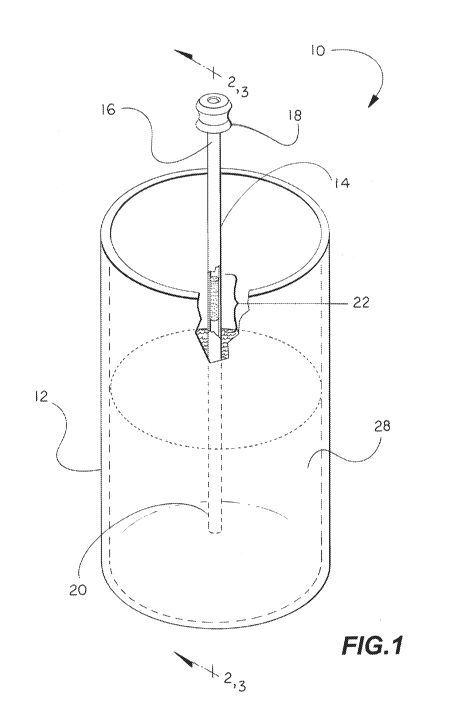Une partie des informations de ce site Web a été fournie par des sources externes. Le gouvernement du Canada n'assume aucune responsabilité concernant la précision, l'actualité ou la fiabilité des informations fournies par les sources externes. Les utilisateurs qui désirent employer cette information devraient consulter directement la source des informations. Le contenu fourni par les sources externes n'est pas assujetti aux exigences sur les langues officielles, la protection des renseignements personnels et l'accessibilité.
L'apparition de différences dans le texte et l'image des Revendications et de l'Abrégé dépend du moment auquel le document est publié. Les textes des Revendications et de l'Abrégé sont affichés :
| (12) Demande de brevet: | (11) CA 3088387 |
|---|---|
| (54) Titre français: | APPAREIL SOULAGEANT LE HOQUET |
| (54) Titre anglais: | HICCUP RELIEVING APPARATUS |
| Statut: | Examen demandé |
| (51) Classification internationale des brevets (CIB): |
|
|---|---|
| (72) Inventeurs : |
|
| (73) Titulaires : |
|
| (71) Demandeurs : |
|
| (74) Agent: | GOWLING WLG (CANADA) LLP |
| (74) Co-agent: | |
| (45) Délivré: | |
| (86) Date de dépôt PCT: | 2019-01-16 |
| (87) Mise à la disponibilité du public: | 2019-07-25 |
| Requête d'examen: | 2023-12-22 |
| Licence disponible: | S.O. |
| (25) Langue des documents déposés: | Anglais |
| Traité de coopération en matière de brevets (PCT): | Oui |
|---|---|
| (86) Numéro de la demande PCT: | PCT/US2019/013728 |
| (87) Numéro de publication internationale PCT: | WO2019/143643 |
| (85) Entrée nationale: | 2020-07-13 |
| (30) Données de priorité de la demande: | ||||||
|---|---|---|---|---|---|---|
|
L'invention concerne un appareil soulageant le hoquet, comprenant un tube doté d'une première extrémité munie d'un embout buccal, d'une seconde extrémité destinée à être immergée dans de l'eau ou un autre liquide potable dans un récipient, et d'une obstruction dans le tube entre la première extrémité et la seconde extrémité. L'obstruction impose à un utilisateur adulte de produire, à l'aide de l'embout buccal, une aspiration seuil d'au moins 20 cm d'eau avant que de l'eau puisse s'écouler à partir de l'eau présente dans le récipient à eau, à travers le tube, à travers l'embout buccal, et jusqu'à l'utilisateur. L'obstruction peut prendre la forme d'un clapet à seuil dans le tube, d'un orifice calibré dans l'extrémité immergée du tube, ou d'un tampon de matériau cellulosique dans le tube.
The hiccup relieving apparatus includes a tube with a first end having a mouthpiece, a second end for immersion in water or other potable liquid in a container, and an obstruction in the tube between the first end and the second end. The obstruction requires an adult user, using the mouthpiece, to produce a threshold suction of at least 20 cm of water before water can flow from the water in the water container, through the tube, through the mouthpiece, and to the user. The obstruction can take the form of a threshold valve in the tube, a sized orifice in the immersed end of the tube, or a wad of cellulosic material in the tube.
Note : Les revendications sont présentées dans la langue officielle dans laquelle elles ont été soumises.
Note : Les descriptions sont présentées dans la langue officielle dans laquelle elles ont été soumises.

Pour une meilleure compréhension de l'état de la demande ou brevet qui figure sur cette page, la rubrique Mise en garde , et les descriptions de Brevet , États administratifs , Taxes périodiques et Historique des paiements devraient être consultées.
| Titre | Date |
|---|---|
| Date de délivrance prévu | Non disponible |
| (86) Date de dépôt PCT | 2019-01-16 |
| (87) Date de publication PCT | 2019-07-25 |
| (85) Entrée nationale | 2020-07-13 |
| Requête d'examen | 2023-12-22 |
Il n'y a pas d'historique d'abandonnement
Dernier paiement au montant de 100,00 $ a été reçu le 2023-12-27
Montants des taxes pour le maintien en état à venir
| Description | Date | Montant |
|---|---|---|
| Prochain paiement si taxe applicable aux petites entités | 2025-01-16 | 100,00 $ |
| Prochain paiement si taxe générale | 2025-01-16 | 277,00 $ |
Avis : Si le paiement en totalité n'a pas été reçu au plus tard à la date indiquée, une taxe supplémentaire peut être imposée, soit une des taxes suivantes :
Les taxes sur les brevets sont ajustées au 1er janvier de chaque année. Les montants ci-dessus sont les montants actuels s'ils sont reçus au plus tard le 31 décembre de l'année en cours.
Veuillez vous référer à la page web des
taxes sur les brevets
de l'OPIC pour voir tous les montants actuels des taxes.
| Type de taxes | Anniversaire | Échéance | Montant payé | Date payée |
|---|---|---|---|---|
| Le dépôt d'une demande de brevet | 2020-07-13 | 200,00 $ | 2020-07-13 | |
| Taxe de maintien en état - Demande - nouvelle loi | 2 | 2021-01-18 | 50,00 $ | 2021-01-14 |
| Taxe de maintien en état - Demande - nouvelle loi | 3 | 2022-01-17 | 50,00 $ | 2022-01-14 |
| Taxe de maintien en état - Demande - nouvelle loi | 4 | 2023-01-16 | 50,00 $ | 2023-01-13 |
| Requête d'examen | 2024-01-16 | 408,00 $ | 2023-12-22 | |
| Taxe de maintien en état - Demande - nouvelle loi | 5 | 2024-01-16 | 100,00 $ | 2023-12-27 |
Les titulaires actuels et antérieures au dossier sont affichés en ordre alphabétique.
| Titulaires actuels au dossier |
|---|
| THE BOARD OF REGENTS OF THE UNIVERSITY OF TEXAS SYSTEM |
| Titulaires antérieures au dossier |
|---|
| S.O. |